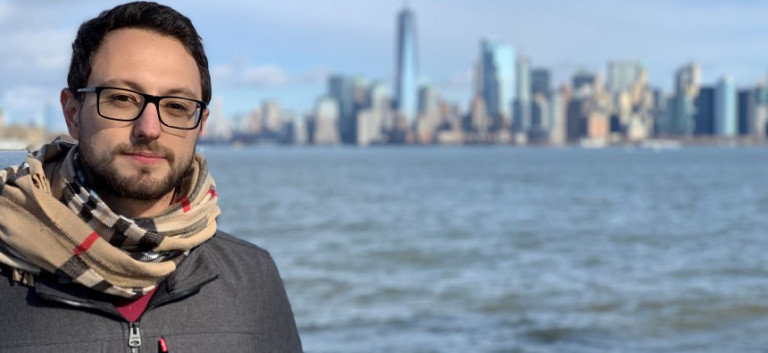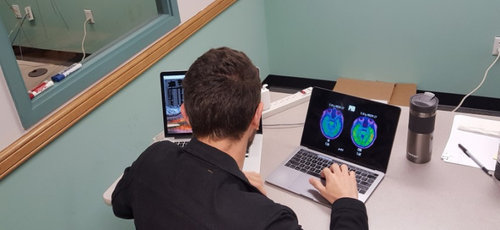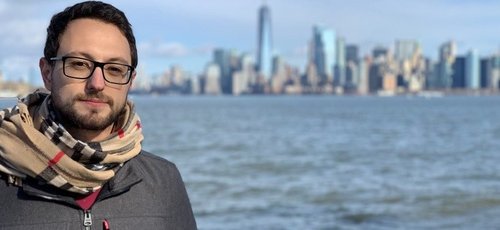Doctoral student returning from the United States study season
The doctoral candidate Wyllians Vendramini, who conducts the Superidosos research project at the Instituto do Cerebro do RS, returned from a six-month study period at the Nathan Kline Institute for Psychiatric Research, an Institute associated with New York University, in the city of New York. He participated in the CAPES Sandwich Doctorate Program Abroad, through the PUCRS School of Medicine. Since January in Rio Grande do Sul, Wyllians return with accumulated experiences in the personal and professional field, and share with us this period of many learnings.
1) Where were you working?
I worked at the Nathan Kline Institute for Psychiatric Research (NKI), an institute associated with New York University. He was in the Center for Biomedical Imaging and Neuromodulation division under the guidance of Dr. Alexandre Rosa Franco. I worked for six months at that institute.
2) How did the possibility of this experience arise?
I completed this period abroad thanks to the Doctorate Sandwich Program abroad (PDSE), launched annually by CAPES. It is an aid program to develop international research and improve techniques. For this, it was essential to have contact with the local teacher, who confirms the acceptance for the period. The Brain Institute was essential in this process, since contact was established through the Institute.
3) What was your routine in the laboratory?
My daily routine involved processing all two hundred images that were collected here in Brazil. What I did was write scripts, correct processing errors and analyze the images. I did this in a unimodal manner, as was foreseen in the project, and multimodal, which was the objective of the project abroad. Thus, it was possible to learn the technique of image fusion to discover changes that a single modality cannot discover. In addition, he participated in biweekly meetings and lectures. I presented the project and the results several times, got suggestions and criticisms that helped a lot in writing the article.
4) Did you work in an environment with people from other countries or were most Americans?
At the Institute, you basically live with all cultures. There is no clear distinction between who is of foreign or American origin: as long as you maintain the level of quality, everyone is welcome. This is one of the characteristics that draws the most attention, because different cultures inevitably contrast and learn from the different. This is one of the fundamental points: to understand that the difference is, in the final analysis, very constructive.
5) How much can this type of international experience contribute to the academic research project?
The contributions to the project are numerous, I will try to list some. Indirectly, living with different cultures encourages you to think in an unexpected way: creativity arises at that moment. Directly, a lot is learned from meetings and discussions with other groups, with criticisms that improve the quality of work. In addition, I learned techniques that are not performed in our country, which I intend to continue using to help other researchers here in Brazil.
6) What is your perception of research laboratories abroad and those here?
The structure of the research environments is very similar. For example, the MRI machines that exist there are easily found in several places in Brazil. I believe that the big difference is in the question of the environment in which the research is. Due to strong funding from the American government, the organization of the research structure takes place very differently. There are, for example, positions for research assistants and researchers who dedicate 100% of their time to create knowledge, which is not so common here. This makes it possible for the research machinery to rotate much faster: collecting, analyzing and writing the data.
7) Are our researches similar to what is produced internationally?
Yes, without a doubt we have very similar research levels. If the context facilitated the collection and analysis of data in Brazil, I believe that we would be able to create high quality and high performance research, in the sense of the amount of knowledge created. However, I still feel a need for Brazil to recognize its own problems in order to use them as a research subject. For example, I see that dementia is a very frequent topic in Brazilian research, but there is still a lack of accurate data to know how many elderly people with dementia we have in our cities.
8) How many is the Superidosos project?
The Superidosos project is at the end of its first part, corresponding to my doctorate. Of course, the project left the research structure as an inheritance, which will be used for other projects and for the continuation of sub-analyzes that may occur.
9) In general, what was that experience like for you as a person?
Fantastic. I would have no other word to describe my experience there. Both personally and professionally, I grew up in an indescribable way. Living with people of other nationalities, creating friends who travel across continents and leaving incredible memories are just a few points I can verbalize. A lot is part of the limbic system.
10) Is living in a city like New York very different than any other place you've been?
It's an insane pace. I did sandwich graduation in Paris for a year and it was completely different experiences. New York has something unique about people and places. It is very easy to adapt to the environment, and soon I already felt part of the city and the pace. It's easy to get used to it.
11) What do you bring with you from all this experience?
In addition to all the analyzes of my doctorate, an article, the security of unfolding English, friends I keep in touch with daily, knowledge of neuroimaging techniques, the hope of creating quality research, many memories. And I miss you, I miss you so much.




